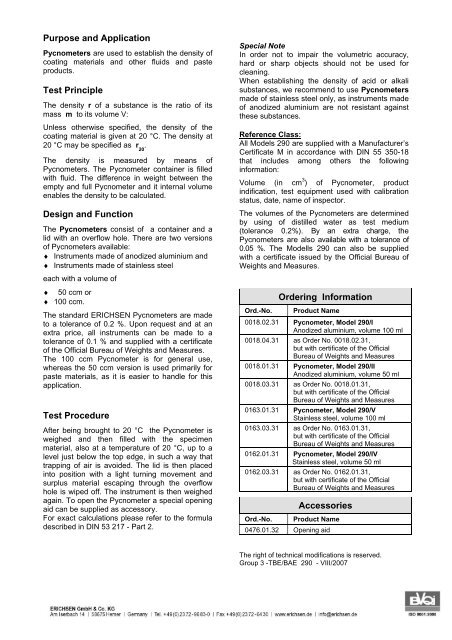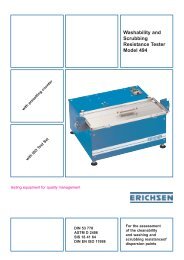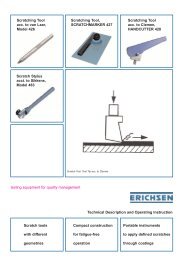Pycnometer Model 290 - Labex
Pycnometer Model 290 - Labex
Pycnometer Model 290 - Labex
Create successful ePaper yourself
Turn your PDF publications into a flip-book with our unique Google optimized e-Paper software.
Purpose and Application<br />
<strong>Pycnometer</strong>s are used to establish the density of<br />
coating materials and other fluids and paste<br />
products.<br />
Test Principle<br />
The density r of a substance is the ratio of its<br />
mass m to its volume V:<br />
Unless otherwise specified, the density of the<br />
coating material is given at 20 °C. The density at<br />
20 °C may be specified as r 20 .<br />
The density is measured by means of<br />
<strong>Pycnometer</strong>s. The <strong>Pycnometer</strong> container is filled<br />
with fluid. The difference in weight between the<br />
empty and full <strong>Pycnometer</strong> and it internal volume<br />
enables the density to be calculated.<br />
Design and Function<br />
The <strong>Pycnometer</strong>s consist of a container and a<br />
lid with an overflow hole. There are two versions<br />
of <strong>Pycnometer</strong>s available:<br />
♦ Instruments made of anodized aluminium and<br />
♦ Instruments made of stainless steel<br />
each with a volume of<br />
♦ 50 ccm or<br />
♦ 100 ccm.<br />
The standard ERICHSEN <strong>Pycnometer</strong>s are made<br />
to a tolerance of 0.2 %. Upon request and at an<br />
extra price, all instruments can be made to a<br />
tolerance of 0.1 % and supplied with a certificate<br />
of the Official Bureau of Weights and Measures.<br />
The 100 ccm <strong>Pycnometer</strong> is for general use,<br />
whereas the 50 ccm version is used primarily for<br />
paste materials, as it is easier to handle for this<br />
application.<br />
Test Procedure<br />
After being brought to 20 °C the <strong>Pycnometer</strong> is<br />
weighed and then filled with the specimen<br />
material, also at a temperature of 20 °C, up to a<br />
level just below the top edge, in such a way that<br />
trapping of air is avoided. The lid is then placed<br />
into position with a light turning movement and<br />
surplus material escaping through the overflow<br />
hole is wiped off. The instrument is then weighed<br />
again. To open the <strong>Pycnometer</strong> a special opening<br />
aid can be supplied as accessory.<br />
For exact calculations please refer to the formula<br />
described in DIN 53 217 - Part 2.<br />
Special Note<br />
In order not to impair the volumetric accuracy,<br />
hard or sharp objects should not be used for<br />
cleaning.<br />
When establishing the density of acid or alkali<br />
substances, we recommend to use <strong>Pycnometer</strong>s<br />
made of stainless steel only, as instruments made<br />
of anodized aluminium are not resistant against<br />
these substances.<br />
Reference Class:<br />
All <strong>Model</strong>s <strong>290</strong> are supplied with a Manufacturer’s<br />
Certificate M in accordance with DIN 55 350-18<br />
that includes among others the following<br />
information:<br />
Volume (in cm 3 ) of <strong>Pycnometer</strong>, product<br />
indification, test equipment used with calibration<br />
status, date, name of inspector.<br />
The volumes of the <strong>Pycnometer</strong>s are determined<br />
by using of distilled water as test medium<br />
(tolerance 0.2%). By an extra charge, the<br />
<strong>Pycnometer</strong>s are also available with a tolerance of<br />
0.05 %. The <strong>Model</strong>ls <strong>290</strong> can also be supplied<br />
with a certificate issued by the Official Bureau of<br />
Weights and Measures.<br />
Ordering Information<br />
Ord.-No. Product Name<br />
0018.02.31 <strong>Pycnometer</strong>, <strong>Model</strong> <strong>290</strong>/I<br />
Anodized aluminium, volume 100 ml<br />
0018.04.31 as Order No. 0018.02.31,<br />
but with certificate of the Official<br />
Bureau of Weights and Measures<br />
0018.01.31 <strong>Pycnometer</strong>, <strong>Model</strong> <strong>290</strong>/II<br />
Anodized aluminium, volume 50 ml<br />
0018.03.31 as Order No. 0018.01.31,<br />
but with certificate of the Official<br />
Bureau of Weights and Measures<br />
0163.01.31 <strong>Pycnometer</strong>, <strong>Model</strong> <strong>290</strong>/V<br />
Stainless steel, volume 100 ml<br />
0163.03.31 as Order No. 0163.01.31,<br />
but with certificate of the Official<br />
Bureau of Weights and Measures<br />
0162.01.31 <strong>Pycnometer</strong>, <strong>Model</strong> <strong>290</strong>/IV<br />
Stainless steel, volume 50 ml<br />
0162.03.31 as Order No. 0162.01.31,<br />
but with certificate of the Official<br />
Bureau of Weights and Measures<br />
Accessories<br />
Ord.-No. Product Name<br />
0476.01.32 Opening aid<br />
The right of technical modifications is reserved.<br />
Group 3 -TBE/BAE <strong>290</strong> - VIII/2007





